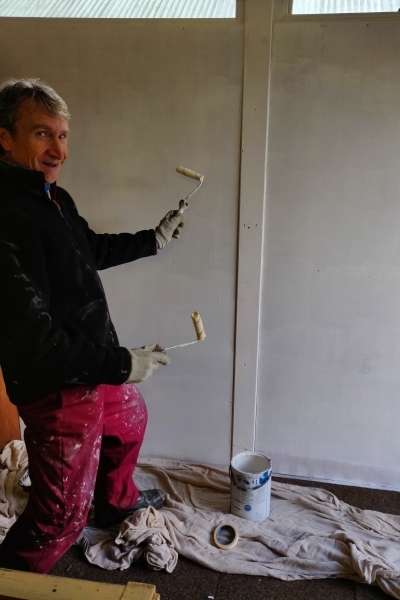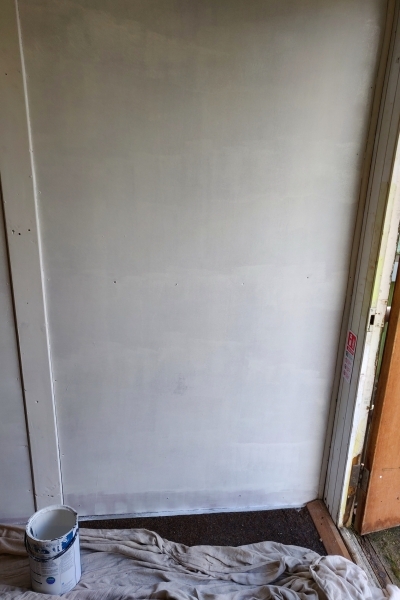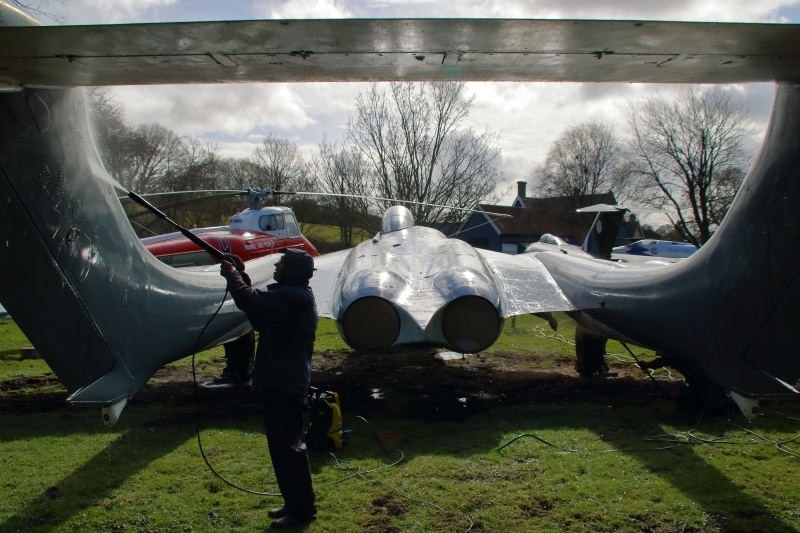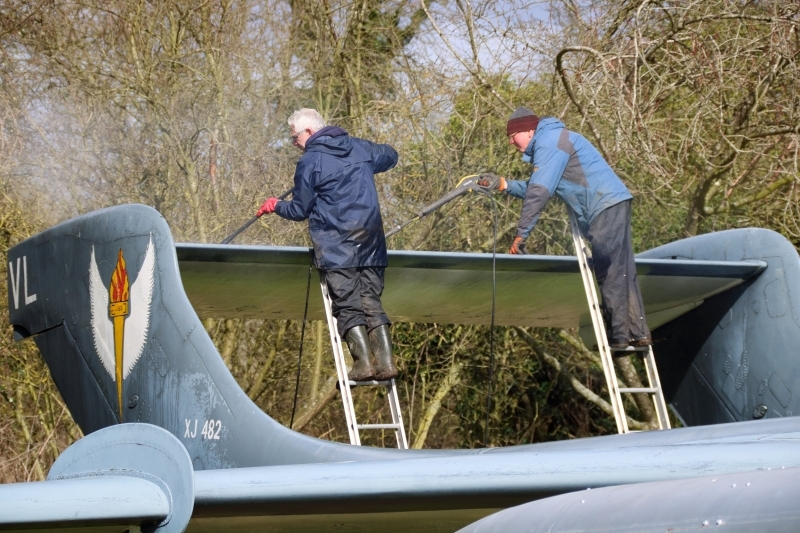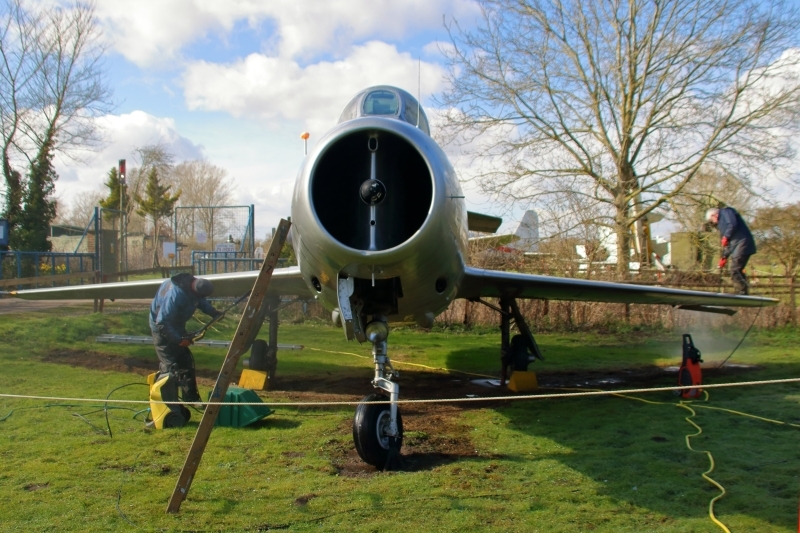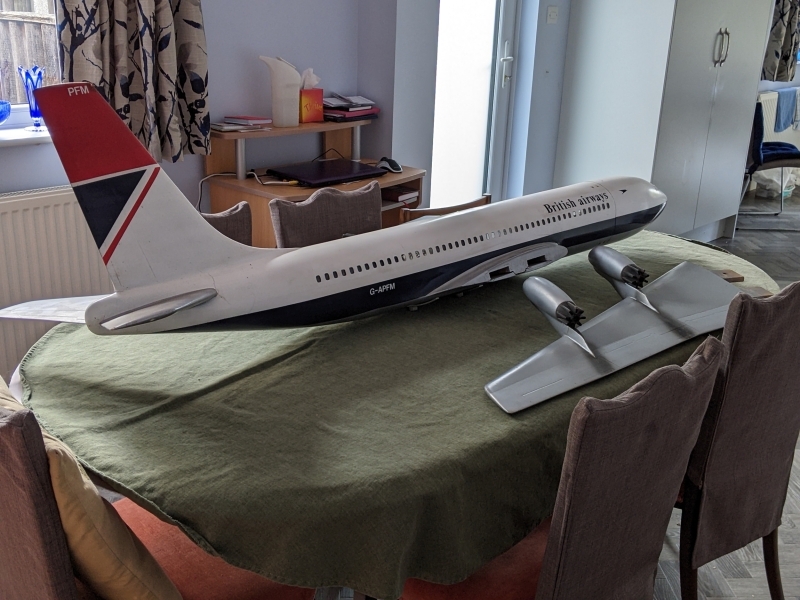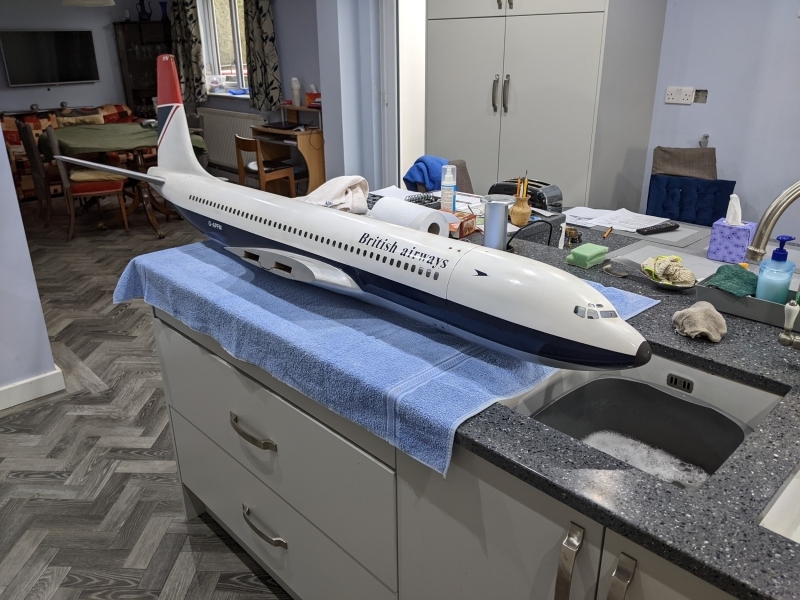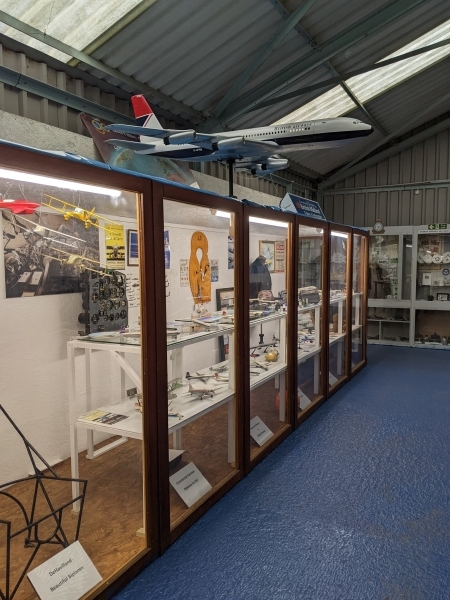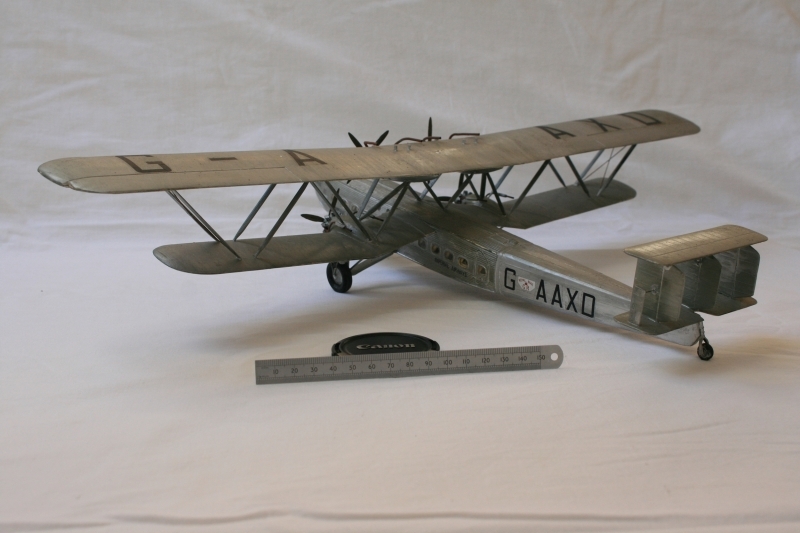NASAM Update as of the 21st Mar 2023
[joli-toc]
From The Teams
Painters Update
07/03/23 – Fair weather painters?
This week’s update is courtesy of Mark K.
With forecasters predicting ‘snowmageddon’ and ‘whiteout’ conditions, some of the team erred on the side of safety and took a ‘duvet day.’
For those that did battle their way to the museum, the heated restoration area provided some shelter for the first job of the day; putting a topcoat of paint onto the three remaining Model display stands.
After that, it was round to the back of the portakabins to clear away the Willow trunks, as recently cut down by Dave D.
Ian could not contain his delight at seeing a tree, a touching moment sensitively captured on film (see pic 09).
After lunch, the team split two ways. Cliff continued preparing a plan for refurbishment of the Valetta this summer, while Mark and Ian undercoated a couple of wall panels in Room 3; a job that took half the time because each member of the Paint Team has now developed the technique of using two rollers at the same time (see pic 10). The team only called it a day when the expected ‘whiteout’ conditions finally did arrive mid-afternoon (see pic 11).
14/03/23 – Under Pressure!
Yes folks, in the words of Frederick Mercury, the team were ‘under pressure’ this week. The rain packed up just as the team arrived, and with a heady 7 degrees predicted, the guys decided to break out the pressure washers again.
Once ‘full wets’ had been donned, Cliff, Mark and Barry headed off for the front paddock in order to continue pressure washing the external exhibits. A bit of hosepipe ‘spaghetti’ then ensued as the boys tee’d off the sole water supply to three different pressure washers. Cliff and Mark then started off on the Sea Vixen with a bit of synchronised pressure washing (see pic 14) before individually making their way around the tail (see pic 12) and down the sides of the tail boom (see pic 13).
Next door, Barry went solo on the T33. By lunchtime, the Sea Vixen was complete and the T33 was cleaned up on the port side. After lunch, Barry finished off the T33 on the starboard side, while Cliff and Mark hopped over onto the Mystere (see pic 15). By the end of the day, the Mystere was complete and there was even time to give the Meteor a quick once-over.
All in all, not a bad result for the day, particularly as the boys battled with a less than optimal level of water pressure to the washers. During the end-of-day cuppa there was a debate over which aircraft were most in need of repainting. The opening gambit had been Hunter and Sea Vixen but by the close of play the Mystere was nudging into the number two slot.
Elsewhere, Gwen finished off painting the back wall in Room 3, while Private Walker was knocking back the Tequilas in Tenerife, nice!
Next week the (pressure washer) guns will be turned on the MiG and the Phantom.
Barry and Mark K
(Photos) Painters Update
![]()
From the Archives
Before and After – Gordon Bennett!!
Recently discovered in the old magazine store, part of the NASAM archive, is a real treasure trove of early aviation – a bound folder of ‘Flight’ magazines dating from June 24th, 1911 – only eight years after the first powered flight had been attributed to the Wright brothers. Each magazine copy was sold, for the princely sum of 3d, under the snappy banner as the ‘Official Organ of the Royal Aero Club of the United Kingdom’. This particular collection of copies is faded, dog-eared and battered around the edges but, throughout the folder, the photos are clear, the diagrams are superbly detailed, and the language decidedly antiquarian.
Today’s subject – there certainly will be others, is concerned with the Gordon Bennett Aviation Trophy race of 1911 when, as an Official Notice to Members (of the Royal Aero Club), the following arrangements for the race were published on page 548:
Before:
The Royal Aero Club of the United Kingdom

The race for the Gordon-Bennett Aviation Trophy will take place at the Royal Aero Club Flying Grounds at Eastchurch, Isle of Sheppey, on Saturday, July 1st, 1911, and is timed to start shortly after 11.30 a.m.
Representatives from the following countries will compete America, Austria, France, Germany, and Great Britain. The race is over a distance of 150 kiloms., roughly 94 miles, and will be on a circuit of about 3 to 4 miles.
Railway Arrangements. A special train at reduced fares will leave Victoria (South Eastern and Chatham Railway) at 9.30 a.m., calling at Herne Hill at 9.40, and arriving at Eastchurch at 11.10.
Admission of Members.
Members of the Club will be admitted free to the members enclosure on production of their membership, cards. These facilities apply to members only, and any friends accompanying them must pay for admission. The price of admission to the members’ enclosure is 5s., and members can now purchase tickets from the Club for admission of their friends.
Motor Cars.-An enclosure will be specially reserved for motor cars, giving an uninterrupted view of the whole Race. The charge for motor cars, including the driver, will be 10s. per car. It would greatly facilitate the arrangements if members purchased tickets for this enclosure beforehand so as to avoid any delay on entering the private road leading to the Aviation Ground.
Refreshments. Arrangements have been made with the Army and Navy Stores, who will erect large marquees, where luncheons, teas, and other refreshments can be obtained.
Dinner to the Competitors. – It is proposed to give an informal dinner to the competitors at the close of the race, when the cup will be presented to the winner. This dinner will be held in a special marquee erected on the ground, and tickets, 5s. each, can now be obtained from the Club.
In order to meet the convenience of those members returning by rail, a special train will be arranged to leave Eastchurch after the dinner.
Members are particularly requested to purchase tickets beforehand so as to facilitate the arrangements.
After:
Fast forwarding now to todays Wikipedia, we can catch up with the background of the race, the originator – and the results:

The Gordon Bennett Aviation Trophy was an international airplane racing trophy that was awarded by James Gordon Bennett Jr., the American owner and publisher of the New York Herald newspaper. Bennett announced a competition for powered aircraft in December 1908, commissioning a trophy from André Auroc, the sculptor who had created the trophies for both the balloon and automobile competitions. Formulation of the competition rules was entrusted to the Aéro-Club de France who decided that the terms of the trophy competition should be the same as those that the Schneider Trophy later adopted: each race was to be hosted by the nation which had won the preceding race, and the trophy would be won outright by the nation whose team won the race three times in succession. After Joseph Sadi-Lecointe’s victory in 1920 the Trophy became the permanent possession of the Aéro-Club de France. It was also decided that each competing nation would be allowed to field a team of three competitors.

The 1911 race was held on the 1st July at the Royal Aeronautical Society’s flying field at Eastchurch, and attracted a crowd of around 10,000 spectators despite the comparative remoteness of the location. The competition coincided with the Circuit of Europe air race, as a result of which the British pilot James Valentine withdrew: however Charles Weymann, the sole American representative chose to withdraw from the Circuit of Europe to take part in the Gordon Bennett competition.
The start of the competition was delayed by poor weather, and the first competitor Gustav Hamel, did not take off until 2:50 in the afternoon. Flying a Blériot XXIII monoplane which had been modified shortly before the race by having its wings cut down by about a metre, he misjudged his first turn and crashed at high speed, astonishingly escaping without serious injury.
At 3:00 Louis Chevalier, flying a Nieuport II powered by a 28 horsepower Nieuport engine. After five laps his engine began showing signs of trouble and he was eventually forced to land after eleven laps, damaging his undercarriage. He then resumed his attempt flying a replacement aircraft, but this also suffered an engine failure shortly after takeoff and he was forced to withdraw.
Charles Weymann took off at 3:45, impressing spectators by the steepness of his banked turns, shortly followed at 4:47 by Alec Ogilvie, flying the aircraft in which he had finished third the previous year, now powered by a 50hp N.E.C engine. Last to take off were Edouard Nieuport and Alfred Leblanc. Leblanc was recovering from influenza and, probably made cautious by Hamel’s crash, did not take the corners as sharply as Weymann, and Nieuport’s aircraft, with a less powerful engine than Weyman’s, was clearly not in serious competition.
|
Nationality |
Pilot |
Aircraft Type |
Pos’n |
Time |
Speed |
Notes |
|
France |
Alfred Leblanc |
Blériot XXIII (100hp Gnome) |
Second |
73 m 40.2 s |
122.17 km/h (75.91 mph) |
|
|
France |
Edouard Nieuport |
Nieuport II 70hp Gnome |
Third |
74m 37.2s |
120.61 km/h (74.94 mph) |
|
|
France |
Louis Chevalier |
Nieuport II (28hp. Nieuport) |
|
|
|
Retired |
|
United Kingdom |
Gustav Hamel |
Bleriot XXIII (100hp Gnome) |
|
|
|
Crashed during race |
|
United Kingdom |
Alexander Ogilvie |
Wright Model R |
Fourth |
109 min 10.4 s |
82.44 km/h (51.23 mph) |
|
|
United States |
C.T. Weymann |
Nieuport IV (100 hp Gnome) |
First |
71m 36.2 s |
125.69 km/h (78.10 mph) |
|
Its more than a little interesting to be able to find adverts and articles in Archive material that can then be followed up with modern resources to complete the full picture – Wikipedia is a great resource to make this possible.
And, in case you’re wondering, James Gordon Bennett, the owner of the New York Herald newspaper and the sponsor of this series of aeroplane races is one of three individuals who are alleged to given their name – by their outgoing nature, energetic behaviour and generally controversial reputation, to the more modern expression of “Gordon Bennett!!!” used to ‘express surprise, contempt, outrage, disgust, or frustration’ and revived by Del Boy Trotter in ‘Only Fools and Horses’.
Graham
![]()
Other Moves Around The Museum
Necessity is the mother of reinvention
On 7th March, the relocated civil aviation exhibit got a step closer to completion with the newly repaired and cleaned 1/24th scale Boeing 707 safely installed above the former uniform cabinet in the Boulton & Paul hangar. It has had a quick repair and clean job, returned from the Flixton WRC (Wortwell Repair Centre) in just two days due to its presence on the dining room table. Thanks to Gary for appearing at just the right moment to help get the hefty beast onto its pole back at the museum.
One task in this winter’s refurbishment programme has been the gathering together of all things Luftwaffe into ‘Luftwaffe Weg’ in the Main Hangar. This meant that the tired looking (comatose?) civil aviation exhibit and the Jack Allen carved wood model collection were earmarked for storage or relocation ’somewhere else’. Storage space was going to be hard to find, but the uniform collection in the Boulton & Paul hangar had just been assessed as largely unfit to remain on display. Muggins here rashly offered to relocate civils and the Allen models to BP in my spare time while designing the new pilot training exhibit in the Link Room. It’s only my second season on Flixton winter programmes, but I still should have known better.
This is a low budget, ‘ move it from A to B’ job. The Chippies have already described how they made something out of almost nothing to provide six more bays’ worth of display frames, modelled on the four recovered from the main hangar civil exhibit. With assistance from Barbara K and Derek O including raids on his local Tesco for boxes, we quickly emptied both old exhibits into the ROC store, with handwritten records of every item and accession numbers where known. Baseline photos of each of the eight original exhibit bays proved invaluable while subsequently typing up the hand written notes.
Last year we decided that in future, displays involving model aircraft should wherever possible use models of the same scale in each display group. Models should preferably be used only to help interpret other objects or images. Starting from what we had in the old exhibit this was always going to be challenging. There are many scales in use for airliners, often on the ‘whatever fits the box’ rule. Models in four or more different scales in one display were not uncommon in the old exhibit. First job back in the warm at WRC was to segregate the many objects that were beyond use. The rest were cleaned and models measured to establish scale.
What you see now is the result of gathering related objects together that present either evolution of civil aviation, or East Anglian regional subjects. Each bay needs to impart something meaningful in about a five second glance. This called for a bit of creativity, so having discovered that we can represent our main drive with a very nice 1/72 scale Viking (Valetta predecessor) and a complete F27 in place of our F27 cockpit, why not show people just how enormous for its day was the HP42 Hannibal biplane, the largest airliner in regular use in the world upon the type’s introduction in 1931. Yes, we just happen to have a rare 1/72 vac form HP42.
Various unrelated DeHavilland full size aircraft components and some of the Jack Allen wooden models from the adjoining exhibit have been used to celebrate the defining shapes of 1930s DeHavilland commercial biplanes, with their tapered wings and stylish rudders.
So, what to do with a Mk2 Comet partial instrument panel? It’s been put into context with a poster sized print on vinyl from EPS of a Comet flight deck photo sourced via the internet from photographer Mick Bajcar. And yes, Comet models, but with a twist, a Caravelle, all in 1/96 scale. (Google it, or better still – see the display)
Regulars may notice that there is none of the original civil flying boat material on display. Fear not, it is hopefully going to be used to fill the space in the case opposite the Felixstowe nose that used to house the Defiant fuselage panel. It will involve posters, photos and small artefacts recording the demise of the mighty Solent flying boats.
Much more signage still to do, and a few models and other objects to be refurbished where they fit the narrative, but all in all, it’s clean, bright and didn’t cost much. Now, back to the day job with the pilot training exhibit…….
Peter W
(Photos) Other Moves
Keep Up To Date
![]() To keep up to date with further information, please keep an eye on our Social Media (see the Social Media buttons at the foot of this blog) or click on the button below to be notified by email of any upcoming changes by seeing the latest blog.
To keep up to date with further information, please keep an eye on our Social Media (see the Social Media buttons at the foot of this blog) or click on the button below to be notified by email of any upcoming changes by seeing the latest blog.


